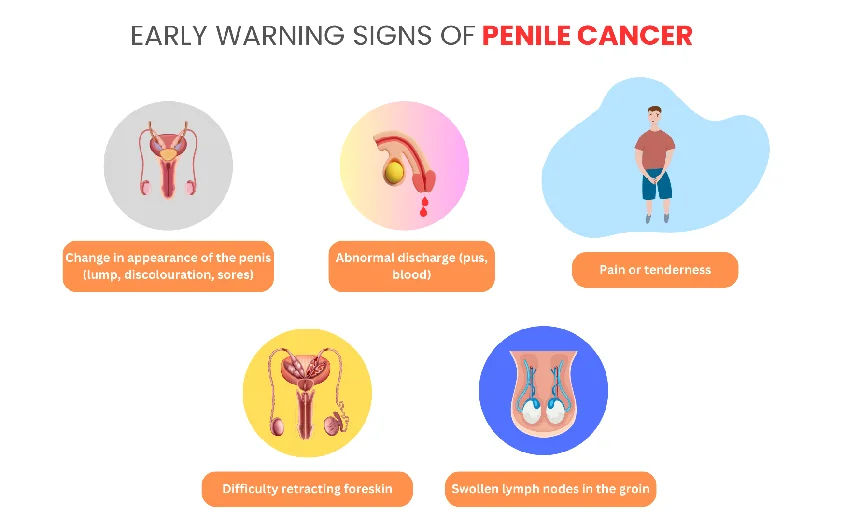Early Signs of Penile Cancer
- Updated on: Jan 27, 2025
- 5 min Read
- Published on Jul 22, 2019
Happy Kumari, MSc, MS

- Medically Reviewed by

What is Penile Cancer?
Penile cancer or cancer of the penis is a rare form of cancer which affects the skin and tissues of the penis. It usually occurs when normal healthy cells in the penis become cancerous and start growing uncontrollably and then form a tumor. The cancer may ultimately spread to other areas of the body like glands, lymph nodes and also some other organs. According to the American Cancer Society approximately 2,300 cases of penile cancer are diagnosed in the United States per year.
One of the most common types of penile cancer is squamous cell carcinoma, which is a cancer that begins in flat cells in the top layer of the skin). This type of penile cancer usually forms on or under the foreskin (the loose skin on the head of the penis). Human papillomavirus (HPV) is the reason behind almost one-third of penile cancer cases. However circumcision (removal of the foreskin of penis) may help to prevent HPV and also decrease the risk of penile cancer. Penile cancer can be cured if found early.

Signs and Symptoms of Penile Cancer
There are a number of symptoms which indicate penile cancer in men. Since penile cancer is rare and all of these symptoms could be caused by some other conditions too, so it is better to consult a doctor whenever the symptoms are found. The most common symptom found in penile cancer is a form of rash, wart-like growth or a lump on the penis, usually on the head of the penis (glans) or beneath the foreskin that doesn’t go away within 4 weeks. Sometimes the lump can be present elsewhere in the groin.
Although the rashes, warts and lumps may not be harmful always and even can be the signs of other conditions, still one should not ignore it and consult a doctor immediately. Some of the common symptoms of penile cancer are:
- Discharge of blood from the penis or beneath the foreskin.
- Discharge with bad smell
- Any kind of color change in the penis or foreskin
- Irritation, itching, discomfort or sharp pain in the penis
- Difficulty in phimosis due to thickening of the skin of the penis
- Difficulty in urination
- Frequent urine infections
- Rashes or warts covering the hole for peeing
- Presence of blood in the urine
- Problems in the erection
- Swelling in the lymph nodes in groin area

Penile cancer in its early stages often appears as small lesions, sores, or lumps on the penis. It may look like warts, ulcers, or red patches. These changes can occur on the glans, foreskin, or shaft. These may be painless initially, which makes them easy to overlook. Early detection through visual inspection and prompt medical attention is important for effective treatment and better outcomes.
What are the Early Signs of Penile Cancer?
Presently no screening test is available that can be effectively used in the general public for the diagnosis of penile cancer. Nevertheless, penile cancer can often be detected in early stages because it usually develops in skin cells and causes noticeable changes in the skin on the penis. But many men do not feel the need to seek medical attention for changes in the skin of the penis. It is therefore important particularly for men who are at high risk of developing penile cancer if they are above the age of 60 and are current or former smokers or have a weak immune system. When penile cancer is detected early, it can be treated properly and even cured with little or no resulting damage to the penis. Some of the important early signs of penile cancer are:
- Changes in the penile skin especially on the glans and shaft
- A thickened area of penile skin near the glans
- Changes in skin color of penis
- Painful or painless lumps on the penis
- Sores which take time in healing or do not heal at all
- Red velvety rashes
- Small sized crusty bumps
- Lesions that are bluish-brown in color
- Foul discharge from the penis
- Swollen lymph nodes in the groin area
- Swelling near the tip of the penis
- Ulceration in the penis
How Does the Penile Cancer Look Like?
Commonly penile cancers appear as a lump, mass or ulcer on the penis. The lesions can be raised and wart-like or simply flat. The penile lesions are sore and inflamed, and there is itching and burning in the region as well. Mostly, penile cancers affect the head or foreskin of the penis rather than the shaft of the penis. The appearance of penile cancers varies significantly from a small bump to very large, infected, and aggressive lesions. The cause for such a wide range of presentations delays the diagnosis.
Some men with penile cancer have swollen groin lymph nodes at the time of diagnosis but only a half of these swollen nodes are due to cancer. The swelling in lymph nodes caused by penile cancer lesions is mostly due to infections. With the progression of the disease, the cancer cells form a raised lesion that can sometimes cause parts of the tissue of the penis to die and erode away. Spread of the disease is very uncommon and symptoms in other parts of the body are generally not found.
Many of the men with penile cancer notice a rash or wart-like growth on the end of their penis, which is usually bright or crimson red in color. Some men find the rashes are white or slightly discolored when compared to the rest of the glans. Some men find this discoloration on the end of their penis for much of their life, get it checked out when they are young but have no problems with it until their cancer starts.
Sometimes a white patch on the glans or foreskin, often accompanied by a tight foreskin may be caused by a skin problem on the penis called as lichen sclerosus. This disease has been found to increase the risk of penile cancer and should therefore be monitored time to time.
Ideally a rash or wart-like growth may be harmless and last for a long time but few changes in its appearance like if it starts to bleed or leak fluid or becomes painful should be monitored and investigated by your doctor.
When to Seek Medical Attention
You should contact a urologist or a general physician (primary care provider) if you notice any unusual changes in your penile area such as persistent sores, lumps, unusual discharge, or discoloration etc. Early diagnosis significantly increases the chances of successful treatment of penile cancer. Don’t ignore persistent symptoms, even if they seem minor, as they could be early signs of penile cancer or other health concerns.
If it is cancer, your doctor may recommend treatments for penile cancer that typically includes surgery, radiation therapy, and chemotherapy, depending on the stage and severity of the condition. In some cases, targeted therapies or laser treatments may also be recommended to preserve as much healthy tissue as possible.












